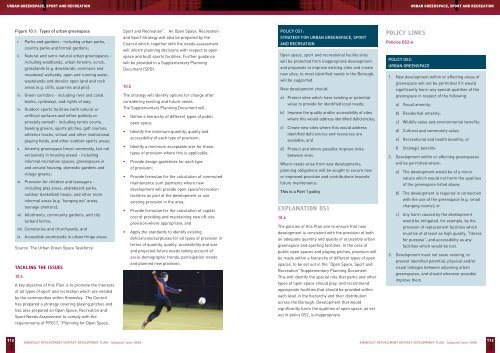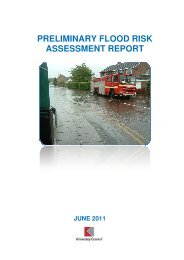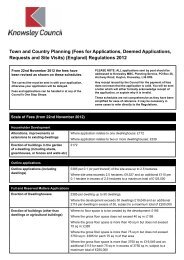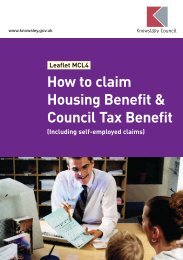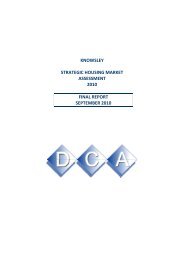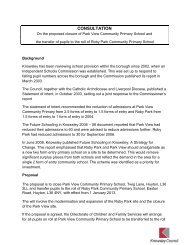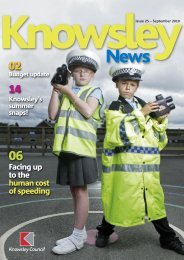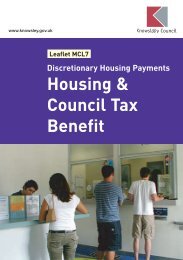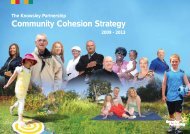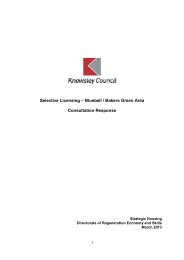Knowsley Replacement Unitary Development Plan - Knowsley Council
Knowsley Replacement Unitary Development Plan - Knowsley Council
Knowsley Replacement Unitary Development Plan - Knowsley Council
You also want an ePaper? Increase the reach of your titles
YUMPU automatically turns print PDFs into web optimized ePapers that Google loves.
URBAN GREENSPACE, SPORT AND RECREATION<br />
URBAN GREENSPACE, SPORT AND RECREATION<br />
Figure 10.1: Types of urban greenspace<br />
i. Parks and gardens - including urban parks,<br />
country parks and formal gardens;<br />
ii. Natural and semi-natural urban greenspaces -<br />
including woodlands, urban forestry, scrub,<br />
grasslands (e.g. downlands, commons and<br />
meadows) wetlands, open and running water,<br />
wastelands and derelict open land and rock<br />
areas (e.g. cliffs, quarries and pits);<br />
iii. Green corridors - including river and canal<br />
banks, cycleways, and rights of way;<br />
iv. Outdoor sports facilities (with natural or<br />
artificial surfaces and either publicly or<br />
privately owned) - including tennis courts,<br />
bowling greens, sports pitches, golf courses,<br />
athletics tracks, school and other institutional<br />
playing fields, and other outdoor sports areas;<br />
v. Amenity greenspace (most commonly, but not<br />
exclusively in housing areas) - including<br />
informal recreation spaces, greenspaces in<br />
and around housing, domestic gardens and<br />
village greens;<br />
vi. Provision for children and teenagers -<br />
including play areas, skateboard parks,<br />
outdoor basketball hoops, and other more<br />
informal areas (e.g. 'hanging out' areas,<br />
teenage shelters);<br />
vii. Allotments, community gardens, and city<br />
(urban) farms;<br />
viii. Cemeteries and churchyards; and<br />
ix. Accessible countryside in urban fringe areas.<br />
Source: The Urban Green Space Taskforce<br />
TACKLING THE ISSUES<br />
10.4<br />
A key objective of this <strong>Plan</strong> is to promote the interests<br />
of all types of sport and recreation which are needed<br />
by the communities within <strong>Knowsley</strong>. The <strong>Council</strong><br />
has prepared a strategy covering playing pitches and<br />
has also prepared an Open Space, Recreation and<br />
Sport Needs Assessment to comply with the<br />
requirements of PPG17, “<strong>Plan</strong>ning for Open Space,<br />
Sport and Recreation”. An Open Space, Recreation<br />
and Sport Strategy will also be prepared by the<br />
<strong>Council</strong> which, together with the needs assessment<br />
will inform planning decisions with respect to open<br />
space and built sports facilities. Further guidance<br />
will be provided in a Supplementary <strong>Plan</strong>ning<br />
Document (SPD).<br />
10.5<br />
The strategy will identify options for change after<br />
considering existing and future needs.<br />
The Supplementary <strong>Plan</strong>ning Document will:<br />
• Define a hierarchy of different types of public<br />
open space;<br />
• Identify the minimum quantity, quality and<br />
accessibility of each type of provision;<br />
• Identify a minimum acceptable size for those<br />
types of provision where this is applicable;<br />
• Provide design guidelines for each type<br />
of provision;<br />
• Provide formulae for the calculation of commuted<br />
maintenance sum payments where new<br />
development will provide open space/recreation<br />
facilities as part of the development or use<br />
existing provision in the area;<br />
• Provide formulae for the calculation of capital<br />
cost of providing and maintaining new off-site<br />
provision where appropriate; and<br />
• Apply the standards to identify existing<br />
deficiencies/surpluses for all types of provision in<br />
terms of quantity, quality, accessibility and size<br />
and projected future needs taking account of<br />
socio-demographic trends, participation trends<br />
and planned new provision.<br />
POLICY OS1:<br />
STRATEGY FOR URBAN GREENSPACE, SPORT<br />
AND RECREATION<br />
Open space, sport and recreational facility sites<br />
will be protected from inappropriate development<br />
and proposals to improve existing sites and create<br />
new sites, to meet identified needs in the Borough,<br />
will be supported.<br />
New development should:<br />
a) Protect sites which have existing or potential<br />
value to provide for identified local needs;<br />
b) Improve the quality and/or accessibility of sites<br />
where this would address identified deficiencies;<br />
c) Create new sites where this would address<br />
identified deficiencies and resources are<br />
available; and<br />
d) Protect and where possible improve links<br />
between sites.<br />
Where needs arise from new developments,<br />
planning obligations will be sought to secure new<br />
or improved provision and contributions towards<br />
future maintenance.<br />
This is a Part 1 policy<br />
EXPLANATION OS1<br />
10.6<br />
The policies of this <strong>Plan</strong> aim to ensure that new<br />
development is consistent with the provision of both<br />
an adequate quantity and quality of accessible urban<br />
greenspace and sporting facilities. In the case of<br />
public open spaces and playing pitches, provision will<br />
be made within a hierarchy of different types of open<br />
spaces, to be set out in the “Open Space, Sport and<br />
Recreation” Supplementary <strong>Plan</strong>ning Document.<br />
This will identify the special role that parks and other<br />
types of open space should play, and recommend<br />
appropriate facilities that should be provided within<br />
each level in the hierarchy and their distribution<br />
across the Borough. <strong>Development</strong> that would<br />
significantly harm the qualities of open space, as set<br />
out in policy OS2, is inappropriate.<br />
POLICY LINKS<br />
Policies OS2-6<br />
POLICY OS2:<br />
URBAN GREENSPACE<br />
1. New development within or affecting areas of<br />
greenspace will not be permitted if it would<br />
significantly harm any special qualities of the<br />
greenspace in respect of the following:<br />
a) Visual amenity;<br />
b) Residential amenity;<br />
c) Wildlife value and environmental benefits;<br />
d) Cultural and community value;<br />
e) Recreational and health benefits; or<br />
f) Strategic benefits.<br />
2. <strong>Development</strong> within or affecting greenspaces<br />
will be permitted where:<br />
a) The development would be of a minor<br />
nature which would not harm the qualities<br />
of the greenspace listed above;<br />
b) The development is required in connection<br />
with the use of the greenspace (e.g. small<br />
changing rooms); or<br />
c) Any harm caused by the development<br />
would be mitigated, for example, by the<br />
provision of replacement facilities which<br />
must be of at least as high quality, “fitness<br />
for purpose”, and accessibility as any<br />
facilities which would be lost.<br />
3. <strong>Development</strong> must not sever existing, or<br />
prevent identified potential, physical and/or<br />
visual linkages between adjoining urban<br />
greenspaces, and should wherever possible<br />
improve them.<br />
112<br />
KNOWSLEY REPLACEMENT UNITARY DEVELOPMENT PLAN: Adopted June 2006<br />
KNOWSLEY REPLACEMENT UNITARY DEVELOPMENT PLAN: Adopted June 2006<br />
113


